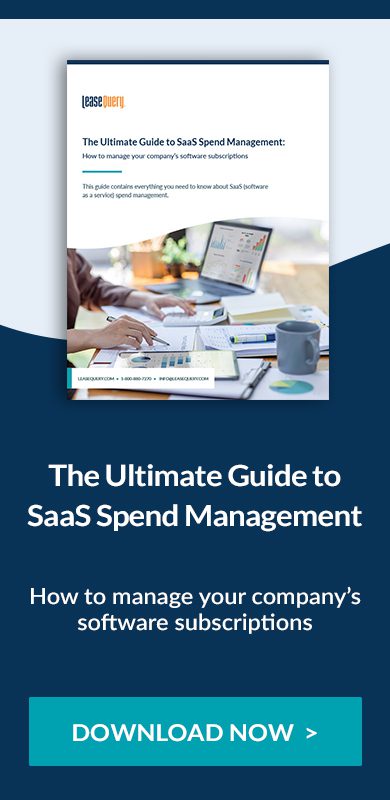One of the key jobs a CFO is tasked with is capital allocation; ensuring dollars are not merely spent, but rather invested in the right people, projects, tools, and assets. In recent years, IT spend, specifically SaaS, has grown to be one of the top 5 spend categories for most companies. According to Gartner, typical companies spend >$2.5 million per year on SaaS, with many organizations spending significantly more.
On a per-head basis, SaaS spend adds thousands of dollars on top of an employee’s salary, bonus, and benefits, but unlike the aforementioned items, driving efficiency and ultimately savings by reducing SaaS spend doesn’t adversely impact morale. While some companies have resorted to outsourcing or headcount reductions to drive margins, attacking SaaS spend has the potential to unlock significant, measurable savings and provide the CFO (and board) with greater visibility and control over one of the largest cost categories.
SaaS management complications
If managing SaaS is such a huge opportunity, why hasn’t every CFO done this? Simply put, like many aspects of a CFO’s job, managing SaaS is hard for the following reasons:
SaaS subscriptions are often complex with a motley of terms and provisions.
SaaS contracts have various approaches to billing and terms that may require monitoring the number of users, types of licenses, amount of usage, or a combination of those, to name just a few.
Procurement of SaaS is frequently driven by departments or individual users, not through centralized procurement like other large areas of spend.
End users of software are naturally the individuals who are most motivated to procure a given application. While there may be a degree of review from legal, finance, or a departmental lead when a new application is purchased, companies seldom have a single leader, or even a team of individuals, who understand the business case, cost, level of utilization and alternative options for each application. Software stacks commonly include more than 100-200 different applications and surveys show software stacks grow as companies age, regardless of whether or not they are scaling.
SaaS costs can be unpredictable, changing based on usage or other contractual terms on a monthly, quarterly, or annual basis.
As SaaS spend has grown, the companies who have attempted to tackle the challenge have done so with spreadsheets maintained by IT, legal and/or finance. The problem with spreadsheets is that they are labor intensive, subject to error, and once created challenging to keep current. Companies are renewing dozens, if not hundreds, of SaaS contracts every year which frequently change terms beyond just price. For instance, annual contracts could become evergreen, transactional pricing could be added, and certain functionality that historically was free could become a premium option that will translate into incremental costs. Tackling SaaS spend requires far more than a list of applications, application owners, and annual spend; it requires up-to-date visibility into contractual commitments and confidence at a senior level that those contractual commitments are being efficiently utilized to drive company growth and ultimately shareholder value.
Large companies that are federated frequently make decisions in silos, duplicating spend and missing out on valuable benefits of being a scaled organization.
For companies with divisions, subsidiaries, departments or geographies operating with degrees of independence, it is not uncommon to spend inefficiently without a single source of truth for SaaS across the enterprise. This dynamic is accentuated in instances of M&A, where a parent company has acquired one or more targets, but has not discovered, reviewed, and optimized the SaaS commitments beyond major applications (e.g., CRM, ERP, etc.)
Is your SaaS stack appropriately managed?
Before a CFO endeavors to tackle SaaS spend, they have to recognize it is not merely an IT issue, or a distributed departmental issue, SaaS spend is a resource allocation issue and as such, it is a finance issue. For those CFOs questioning their SaaS spend fitness, here is a quick litmus test comprised of questions you should be able to quickly answer if you believe you have your SaaS stack appropriately managed and why this knowledge is important.
What is your total and per head, SaaS spend on an annual basis for the company and each department?
For companies that are growing, moving, or reducing headcount, knowing the SaaS expenses associated with employees in specific roles is essential to understanding the cash impact of strategic, personnel-related decisions. Also, for annual budget cycles, it is important to understand historical, run-rate and projected SaaS for each department.
Of your budgeted SaaS spend over the next four quarters, how much of your spend is available vs committed?
For companies looking to achieve cost savings, it is important to identify which vendor contracts are renewing within a certain time period, because SaaS spend not up for renewal within a given year is not relevant for purposes of identifying departmental or companywide savings.
For available spend, in what quarters are your biggest commitments renewing, and when are the notice periods to the extent you want to renegotiate certain provisions (e.g., pricing) or eliminate a vendor?
Switching software isn’t always straightforward and requires planning. Notice periods commonly range from 30-90 days in advance of a renewal and if proper notice isn’t provided, the subscription frequently renews for a year (or longer). Mapping out notice periods is essential to be able to renegotiate or successfully allocate enough time to identify a new application and complete the implementation.
Of your available spend, how much is driven by license or headcount-based models versus transactional or volume models?
After a thorough review of SaaS utilization, it will be important to identify applications that have per seat or per license models. In instances where software is underutilized or headcount is being reduced, per user and license models provide the opportunity to reduce spend, whereas many transactional or volume-based applications may not.
Is your SaaS spend being fully utilized by those who have paid access?
Licenses to software can cost thousands of dollars (or more) per year; however, it is not uncommon for many organizations to provide employees with paid software access based on their department or role, regardless of whether or not they have requested a certain application. Office and video conference applications are common examples where organizations distribute access broadly. However many specialized employees simply do not need the level of access provided. Without a utilization report, showing who and how often people log in on an app-by-app basis, it is nearly impossible to unlock these types of savings.
How does the price and subscription level you are utilizing compare to that of other companies?
Although some software vendors such as consumer-facing, product-led growth companies, provide pricing on their website, most companies only provide quotes to prospects who have gone through the time-intensive process of observing a demo. The opacity of pricing within software means that two companies of similar size and characteristics could be paying drastically different prices for the same application. By finding a SaaS spend player that tracks and analyzes spend data associated with SaaS contracts, customers can understand key provisions they can negotiate for in their upcoming renewals.
Do you know the aggregate embedded rate increases in total and by department for your existing contracts, and is this detail driving your budget?
For budgets and forecasts, knowing specific, not general, price increases are vital to maintaining a firm grip on spend. In recent years, many SaaS vendors have increased pricing well above the historic 3-5% assumptions included in most contracts. Looking across each contract and the terms that drive actual price increases is essential. Missing actual price increase metrics by a few percentage points can amount to hundreds of thousands of dollars.
When are cash renewal payments due for each application?
Many companies have periods throughout the year when cash and cash flow are lower than other periods. Knowing renewal timing and when cash payments are due is vital to forecasting expected free cash flow.
Where does redundancy exist within my SaaS applications and which individuals are users of redundant software? Are individual users accessing apps with overlapping functionality?
While recognizing redundancy is essential, it’s equally important to determine who the regular users are for these redundant apps. Understanding individual usage patterns helps shed light on whether multiple employees access both apps or if specific teams are using them exclusively.
Navigating the complex landscape of SaaS spending with finance-driven solutions
A SaaS spend management platform is an essential and invaluable tool for finance leaders. The significance of such a solution becomes evident when considering the various questions and issues CFOs face around SaaS spending.
Many CFOs struggle to efficiently handle SaaS spending due to its unique nature as a hybrid concern between finance and IT domains. While IT focuses on usage and technical aspects like infrastructure and security, finance needs answers to entirely different sets of questions related to financial efficiency. This highlights why a finance-driven SaaS spend management solution is paramount in optimizing organizations’ software expenses without compromising compliance standards.
A good SaaS spend management solution will:
- Provide visibility into all SaaS subscriptions on a company and department level
- Provide visibility into utilization by application
- Track spending trends and provide reports that help drive the budget process
- Identify actionable opportunities for cost savings
By providing these insights, a SaaS management solution empowers CFOs with comprehensive visibility into one of the largest areas of organizational expenditure.
In conclusion, effective SaaS spend management is essential for CFOs to ensure their organizations are getting the most out of their SaaS investments – and can be greatly enabled by using a SaaS spend management tool. By using a finance-driven solution, CFOs can gain a comprehensive view of their SaaS spend, identify areas for optimization, and maximize economic returns. This can lead to significant cost savings and improved operational efficiency, which can help businesses achieve their financial goals.





